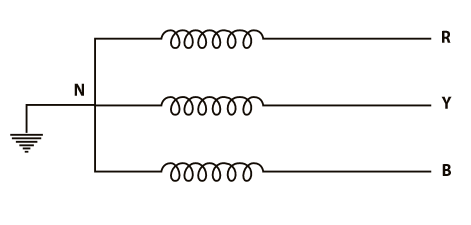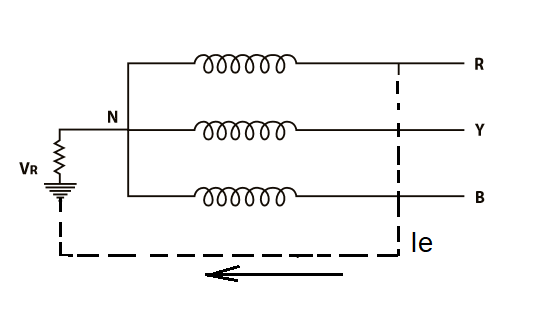Earth and Unearth cables are two types of power cables. The selection of cable is decided on the basis of system in which it is to be used. There are two different types of system on the basis of neutral earthing: Earth and Unearth System. Cable used in system where the neutral is grounded is called Earth Cable. Whereas cable used in Unearth system is called Unearth Cable.
Before we discuss about these types of cable, it is imperative to know the voltage nomenclature of power cables. As per IEC 60502 Part-2, the rated voltage of cable is specified as
“U0/U where U0 is the rated power frequency voltage between conductor and earth or metal screen to ground and U is the rated power frequency voltage between conductors of cable.”
Based on the above nomenclature, a cable having voltage rating of 3.8 kV / 6.6 kV means the phase to ground voltage of cable is 3.8 kV whereas that of phase to phase voltage is 6.6 kV. Let us now try to understand the requirement for segregation of cable into Earth and Unearth cable. For this, first of all we need to understand the Earth and Unearth system and variation of phase to ground voltage in both the systems during fault condition.
Earth Cable:
An electrical system in which neutral point is grounded is called Earth System. Such a system is shown in figure below:

The main advantage of the Earth system is that neutral voltage is always clamped to earth potential irrespective of the system operating condition. This means even when phase to ground fault occurs, the neutral potential will be maintained zero. This means healthy phase to ground voltage will remain fixed to its normal phase to ground voltage. For example, if the system voltage is 6.6 kV, the phase to ground voltage will be (6.6 / √3) = 3.8 kV. Under the condition of phase to ground fault (say R ph to earth fault), the voltage of remaining healthy phases i.e Y-E and B-E voltage will be maintained at 3.8 kV.
The cable used for such system should be designed to withstand voltage stress equal to phase to ground voltage. Thus, for our example, the insulation of between conductor to armour (Earth) should be designed to withstand 3.8 kV. Therefore, the voltage rating of Earth cable will be 3.8 kV / 6.6 kV.
Unearth Cable:
A system in which system neutral is grounded through resistor/reactor or not grounded at all is called Unearth System. Generally, to limit the fault current in electrical distribution system, neutral is grounded through resistor. The value of resistor is so chosen to limit the earth fault current to safe level. This is required to prevent damage of the system components viz. transformer, generator etc. form high value of earh fault current.

In such system, during phase to ground fault, the fault current passes through the resistor connected in the neutral. This causes neutral point voltage to shift from zero to negative (equal to faulted phase voltage). This causes, voltages of other two healthy phases (B and Y in our example) to rise with respect to the earth by √3 times. To better understand, how to healthy phase voltage rises, you may read Ungrounded System.
Thus, we see that in an Unearth system, the phase to ground voltage rises to √3 times of normal phase to ground voltage. In view of this, a cable used for such system should have insulation to withstand √3 times (which is equal to phase to phase voltage) of normal phase to ground voltage. This is required as during fault condition the voltage of healthy phases to ground voltage becomes equal to phase to phase voltage.
Thus, the voltage rating of Unearth Cable must be 6.6 kV / 6.6 kV unearth cable or 6.6 kV / 11 kV earth cable for a 6.6 kV System.
From the above voltage rating, it is clear that 6.6 kV / 11 kV (Earth) cable may also be used for an Unearth System of 6.6 kV (Phase to phase voltage). Mind that during phase to ground fault, the voltage of healthy phase to ground voltage will become 6.6 kV. This is the reason, earth cable having voltage rating of 6.6 kV / (6.6x√3 =11) kV is used for Unearth System.
Difference between Earth Cable and Unearth Cable:
- The insulation strength of Unearth Cable is more as it has to sustain phase to phase voltage during earth fault condition. Earth cable should never be used for an Unearth system. This may lead to puncture of insulation of cable during earth fault.
- The voltage rating of earth cable is in the form of 3.8 kV / 6.6 kV, 6.6 kV / 11 kV. However, the voltage rating of Unearth cable is given in form of 3.3 kV / 3.3 kV, 11 kV / 11 kV. Notice that, while specifying the voltage rating of Unearth cable, the phase to ground and phase to phase voltages are equal.
- A 6.6 kV / 11 kV earth cable can be used for a 6.6 kV Unearth Cable. This is because each core of cable is designed to withstand a voltage of 6.6 kV phase to ground. Similarly, a 6.6 kV / 6.6 kV Unearth cable can be used for 6.6 kV / 11 kV Earth System. This is because, each core of unearth cable is designed to withstand 6.6 kV phase to ground and hence a phase to phase voltage equal to 6.6x√3 kV = 11 kV.
Hope you enjoyed the post. Your suggestion and value addition is important to us. Kindly share if you like the post.
Respected sir,
kindly give some information about cable under lying process with use of SVL( Suurge voltage limiter)